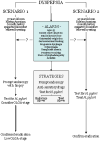Clinical practice: diagnosis and evaluation of dyspepsia
- PMID: 20009950
- PMCID: PMC2828509
- DOI: 10.1097/MCG.0b013e3181c64c69
Clinical practice: diagnosis and evaluation of dyspepsia
Abstract
The main issue regarding the approach to the patient with uninvestigated dyspepsia is whether the symptoms are the result of an important clinical illness, which then determines the appropriate management strategy for the treatment of the symptoms. An initial trial of empiric antisecretory drugs is recommended for those without Helicobacter pylori infection and no alarm symptoms, whereas H. pylori eradication is recommended for those with an active H. pylori infection. Treatment expectations for H. pylori infections should theoretically be similar to other common infectious diseases. In most regions, clarithromycin resistance has undermined traditional triple therapy so that it is no longer a suitable choice as an empiric therapy. Four drug therapies, such as sequential, concomitant, and bismuth-quadruple therapy are generally still acceptable choices as empiric therapies. Posteradication testing is highly recommended to provide early identification of otherwise unrecognized increasing antimicrobial resistance. However, despite the ability to successfully cure H. pylori infections, a symptomatic response can be expected in only a minority of those with dyspepsia not associated with ulcers (so called nonulcer dyspepsia). Overall, from the patients stand point, symptomatic relief is often difficult to achieve and physicians must rely on reassurance along with empiric and individualized care.
Figures
References
-
- Clouse RE, Mayer EA, Aziz Q, et al. In: ROME III The functional gastrointestinal disorders. 3. Drossman DA, Corazziari E, Delvaux M, Spiller RC, Talley NJ, Thompson WG, et al., editors. Allen Press; Lawrence, KS: 2006. pp. 557–594.
-
- Drossman DA. Rome III: the new criteria. Chin J Dig Dis. 2006;7:181–185. - PubMed
Publication types
MeSH terms
Substances
Grants and funding
LinkOut - more resources
Full Text Sources
Other Literature Sources
Medical



